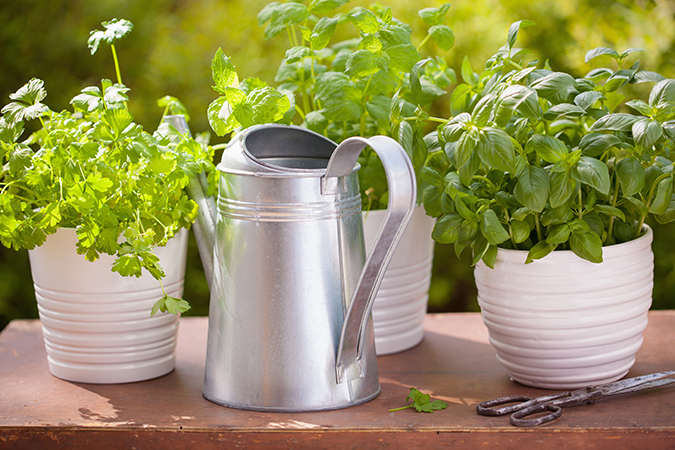(Length: 1:16 minutes)
How old are the spices in your spice cabinet?
If you’re like me, some of spices and seasonings might be just slightly older than two to three years—the point at which they lose potency and should be discarded.
But what if you could have a continual supply of homegrown spices and seasonings that you use most, without having to worry about an expiration date?
In this quick video, I show you a quick solution—a living spice cabinet on your kitchen windowsill filled with homegrown spices and seasonings.
I grow basil, chives, thyme, oregano, rosemary, and sage.
These are all excellent choices for indoor container gardening. And you can add parsley, horehound, winter savory, dill, marjoram, coriander, and mint to that list.
Whether you’re a well-established gardener or your gardening skills are just starting to bloom (sorry, couldn’t resist! 😉 ), you’ll need a few things to get your living spice cabinet started.
Environment: Right Plant, Right Place
One of the most basic principles of successful gardening is “right plant, right place.”
Basically, if you grow a plant in an environment that meets its basic needs for sunlight, temperature, airflow, soil drainage, etc., you’ll be doing yourself a huge favor in the long run.
Your plant will be stronger, healthier, happier, and more productive; have fewer disease and pest issues; and create fewer headaches for you!
So, before you head to the garden center for pots and seedlings, take a few minutes to determine how you’ll provide the right environment for your herbs.
Here’s what you’ll need to consider:
- Light Sources
Sunlight: Most herbs need six to eight hours of sunlight daily. You can usually provide this via an unobscured window with western or southern exposure. To ensure that the entire plant gets adequate sunlight, rotate it every three to four days.
Artificial Light: If you don’t have an indoor location that provides enough natural light, you can use two 40-watt cool white fluorescent bulbs. Place the plants 6 to 12 inches below the light source, and keep the bulbs lit for two hours per hour of required sunlight. For example, if your plants need eight hours of sunlight, expose them to 16 hours of artificial fluorescent light daily. And if you don’t want to mess with turning the lights on and off at certain times each day, consider buying a plug-in timer to handle the task for you. (Trust me, they’re awesome. Highly recommended!)
- Temperatures
Herbs prefer moderate temperatures, so choose a location that reaches 65°F–70°F during the day and 55°F–60°F at night. Avoid temperature extremes by keeping your herb plants away from mechanical heat sources and out of chilly drafts.
- Humidity
Herbs will grow best in a somewhat humid environment. So, if you live where it’s arid, you’ll need to get creative to provide supplemental humidity. You might fill a tray with stones, set your pots in it, and keep it filled with water just to the bottom of the herb containers. Alternately, you can keep a spray bottle handy and mist your herb plants with water as needed.
- Airflow
Like many other plants, herbs do best with good air circulation. So be sure not to crowd your plants together, maintaining a bit of space between them. And, when possible, crack a window or turn on a fan to keep some air flowing in the area.
Materials: Four Essentials
Now that you’ve figured out the best spot in your house for your homegrown spices and seasonings, it’s time to go shopping—either in your potting shed or at your local garden center!
Here’s what you’ll need:
Fast-Draining Growing Medium
Look for a potting mix designed to drain fast and control moisture.
The main ingredient will be coir or sphagnum peat moss. These amendments have a large texture that helps the soil stay aerated and well drained, and their natural absorptive properties help keep the soil moist. (Interestingly, the more sustainable choice of the two, coir, is also the most useful. Not only is it a renewable resource produced from coconut husks, but it absorbs nearly a third more water than peat, is much easier to re-wet when it’s dry, is more alkaline, is slower to decompose … the list goes on.)
The ingredient list will also include some combination of water-holding minerals, such as vermiculite or perlite.
Many growing mediums will also include additions like compost, fertilizer, and wetting agents.
Or, you can be like Grow Network, Change Maker, David the Good and make your own!
Liquid Fertilizer
Think fish emulsion and seaweed. Make your own liquid fertilizers centered on these ingredients here, or find some premade options at your local garden center.
Recommendations vary on how often to feed your culinary herb plants. Some say to use low-dose liquid fertilizer every couple of weeks, while others recommend feeding them every four weeks, or even less often. If you’re concerned about overfeeding, let your plants be your guide. If they look lush but have poor flavor, it’s time to cut back on the fertilizer.
Plants
Many people prefer to plant seedlings because they get you to your goal of freshly harvested herbs that much faster. However, if you’re willing to wait a little longer, grow your herbs from seed. In either case, follow the planting directions provided on the pot or seed packet, and you’ll have homegrown spices and seasonings in no time.
Water: The Final Ingredient
Finally, remember to water your herbs—but just occasionally.
Almost all herbs grown indoors will do best if you let their soil dry out between waterings. You’ll know it’s time to water if, when you stick your finger into the soil to a depth of one-inch, the soil is dry. Rosemary is the exception to this rule. Its soil needs to be kept moist.
It’s Time to Spice Things Up!
With just a few simple materials, plus a careful choice of environment, you’ll have homegrown spices and seasonings in YOUR living spice cabinet, just like mine.
It will add visual and aromatic appeal to your home and your meals—and, perhaps best of all, help ensure that your favorite spices are always fresh and full of flavor!
What are your favorite spices to grow? Do you have a living spice cabinet? Let us know in the comments below.









COMMENTS(19)
Even though I have a large outdoor garden, with a variety of fruits and vegetables, I seem to get the most satisfaction from harvesting fresh herbs, as my whim dictates. Frequently, I’m out there with a flashlight, hoping I don’t step on a snake, or get jumped by fire ants! So, I love this idea – especially for apartment dwellers, or areas with a long winter freeze. Some windowsill gardeners may need to add a tiny grow light, in order to keep the plants healthy. But, there are many small, unobtrusive new fixtures available, that make supplementing your indoor light easy.
With current research proving that common herbs are the sleeping giants of health and wellness, the value of using them regularly and abundantly is now quite clear. Thanks for putting this out there.
Love this idea. Have for a long time.
Husband and I have enjoyed our herb and spice garden on the side of our house now for about 6 years. We have Ginger, Thai ginger, Lemongrass, Vietnamese mint, Korean Perilla, tarragon, parsley, sage, stevia, sorrell, chives, rosemary, marjoram, oregano, even have rhubarb and bell peppers in there and I often find the passionfruit vine dropping passion fruit in there as well.
Also have the garden out back as well and it is a real blessing to
look at what is on our plates and have some or most of it grown ourselves.
Cherry tomatoes wrapped in perilla leaf and bacon roasted on the grill is delectable. Plus I can make Asian wraps with the hard to find expensive asian herbs any time I want. Or I can whipp up a batch of Thai chicken coconut soup because I have the Thai ginger, lemongrass and the thai lime tree in the backyard. So I get you Marjorie and it is amazing to grow your own herbs and veggies. We are branching out into aquaponics and (growing fish and veggies in a symbotic relationship) and I am planning a chicken tractor for next Spring. You inspire me! Thanks for all you do!
Oh Stephanie,
Can I come over for dinner? LOL
Great tip!
my kitchen window is the only one…and it is on the NORTH wall…
I may have to improvise and grow my own herbs in the MUDRoom. it gets western sun and there is space for it.
love this idea.
Pat
Pretty neat!
Awesome! Now you need a little aquaponics system and you can grow all your produce, too!
Thanks Marjory! I’ve learned quite a bit already from your simple lessons in wisdom and independent living. I look forward to hearing more of what you and others far wiser than I have to say and teach. May the creator bless, guide and protect you always!
Thank you Krys.
I have tried and tried to start a spice rack. I have tried growing from seed. They sprout and look good, and always die before the secondary leaves get established. I have tried buying the small pots from the garden displays at the co-op, but they always die on me!! I leave them in the window so they can get sun, I water them, but they always turn yellow and then die. or they will look fine and I will come home at the end of the day and find them lying over the edge of the pot dead! I have no idea what I am doing wrong. I keep trying, it has to work eventually! Right now I one chive pot that is still rather small but weak looking. Any suggstions!!!
Hi Fayette, be careful not to over-water and that the pots have good drainage. Herbs can be a little tricky, especially when it comes to their fragile roots. Also, be sure that you have a good potting soil with plenty of nutrients for your young sprouts. Trial and error is always a part of growing, but don’t get discouraged. Keep researching for your particular setup and ask questions…you will be successful! 🙂
Molasses and fertilizers for my garden
We have the molasses and I want to know from you the percentages of milk, sugar cane molasses and other fertilizers that can be added to molasses and milk to be a good thing for soil and plants.
Question … Is that 8 hours of direct sunlight through the window or would 8 hours in a bright (but not sunny) window be sufficient?
Most of the plants listed (if not all) are not spices, but are herbs. Spices are bark, roots, seeds. Herbs are leaves and stems.
This is a very helpful site. I love growing culinary herbs as well as vegs. This year I grew tomatoes, several different peppers,onions,beets,squash,okra,lettuce and cucumbers.
Thank you for all your helpful ideas.
Hi there.I am desperate,please help me.I am trying to find out whether its possible to use compost tea,molasses,epsom salts,cow manure tea,baking soda in hydroponics/kratky method???How can these be preserved to avoid going bad???
I will water my window herbs with leftover coffee or tea (diluted) or, water from soaking beans or almonds. They are thriving.
I’d like to try growing cinnamon, nutmeg and cloves. But I think they may be too big for inside the house. Do you know small you can keep these, and still have them be useful as spices?
I have a 5×5 east facing window that I’d love to put an herb garden for the whole thing – just remove the vertical blinds, and have the plants be the ‘blinds’. Almost like an ‘herb wall’, if that makes sense. Still haven’t figured out how best to go about it, though.